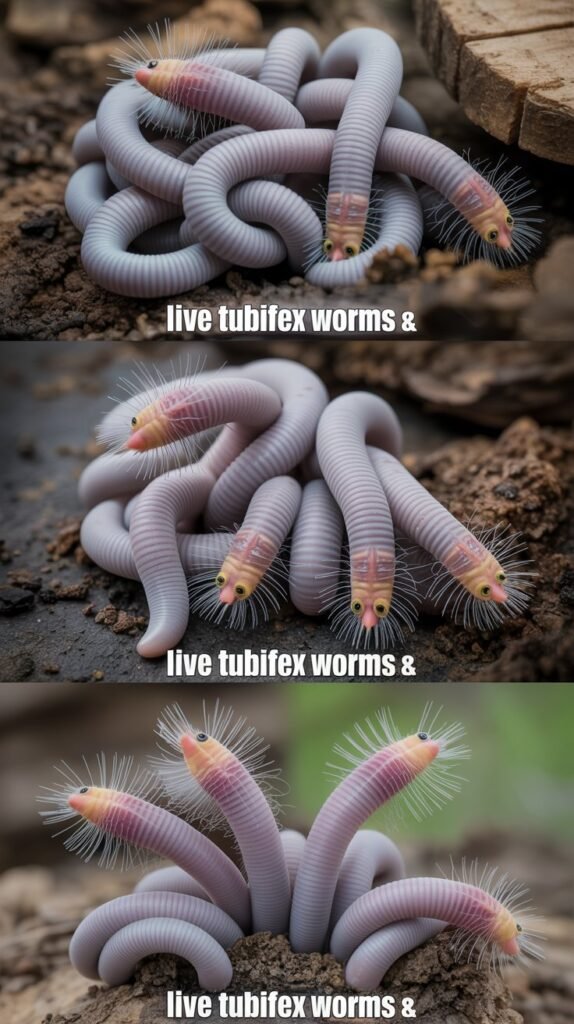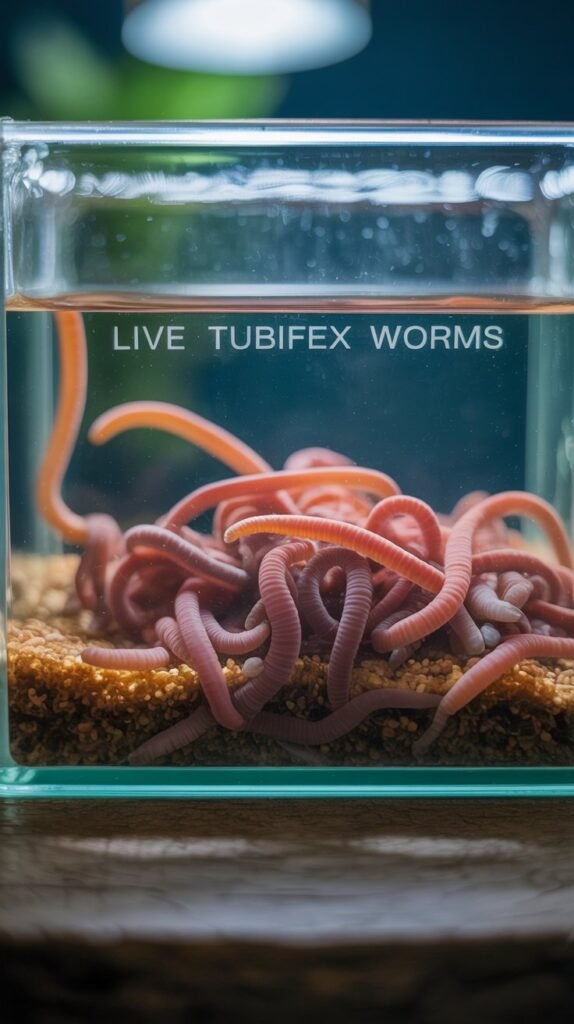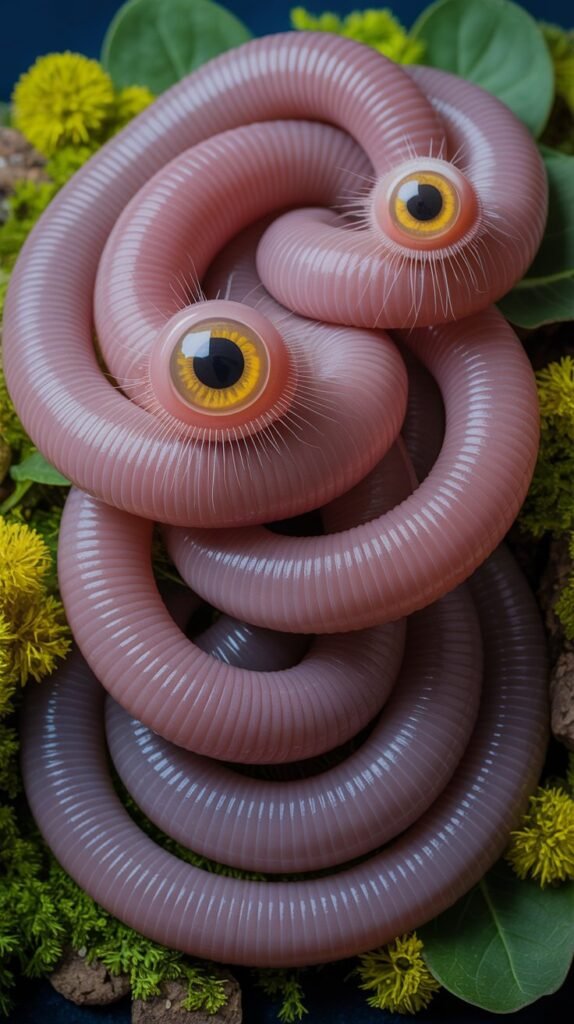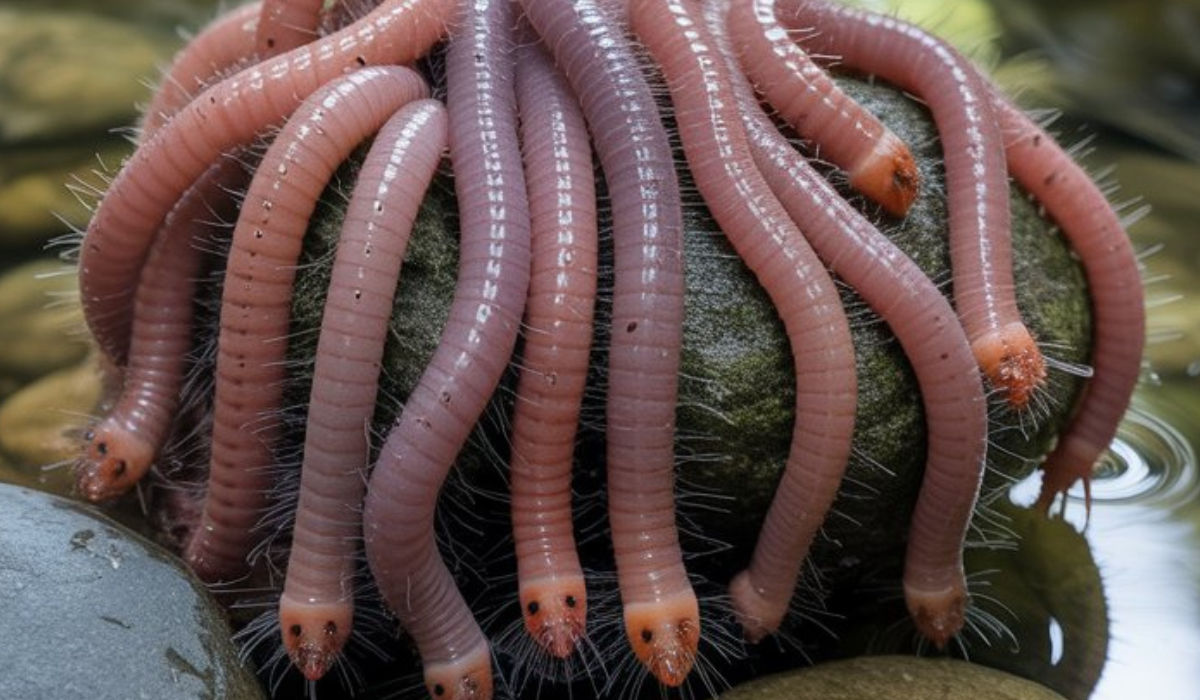Live foods are an important part of aquarium fish care, especially for those who want their fish to thrive with natural nutrition. Among the many live foods available, live tubifex worms are one of the most debated and commonly used options. While they are packed with protein and beneficial nutrients, they also come with potential risks if not handled correctly. For aquarists raising guppies, bettas, cichlids, goldfish, or even larger carnivorous fish, tubifex worms can be an excellent live food source if used responsibly.
In this article, we will explore everything about live tubifex worms—their nutritional value, benefits, risks, how to culture them, how to feed them safely, and frequently asked questions.
What Are Tubifex Worms?
Tubifex worms (Tubifex tubifex) are thin, reddish-brown aquatic worms that naturally live in the sediments of rivers, lakes, and ponds. They thrive in environments rich in organic waste, which is why they are often associated with polluted waters. These worms form colonies, burrowing into soft mud while keeping their tails above the surface for oxygen exchange.
In the aquarium hobby, tubifex worms are harvested from natural habitats and sold as:

- Live Tubifex Worms – Fresh worms kept alive for direct feeding.
- Frozen Tubifex Worms – Frozen blocks or cubes, safer for fish but with less nutritional activity.
- Freeze-Dried Tubifex Worms – Dried for convenience, long shelf-life, but less palatable than live.
Among these, live tubifex worms are the most nutritious but also the riskiest due to potential contamination.
Nutritional Value of Live Tubifex Worms
One of the main reasons aquarists use tubifex worms is their exceptional protein content. Protein is crucial for growth, coloration, and breeding success in aquarium fish.
Nutritional Breakdown (approximate values per 100g of dry matter):
- Protein: 55–60%
- Fat: 10–12%
- Fiber: 2–3%
- Moisture: 80–85% (in live worms)
- Minerals: Calcium, phosphorus, iron, magnesium
This makes them ideal for fry (baby fish), breeding adults, and carnivorous fish that need high-energy diets.
Benefits of Feeding Live Tubifex Worms
1. High Protein Content
The high protein levels support rapid growth, especially in young fish and fry. Guppies, mollies, bettas, and other livebearers grow faster and develop vibrant colors when fed live worms occasionally.
2. Encourages Natural Hunting Behavior
Fish are naturally hunters. Feeding live worms allows them to chase, bite, and forage, which keeps them active and mentally stimulated.
3. Boosts Breeding Success
Protein-rich diets help condition fish for breeding. Female guppies and egg-laying species produce healthier fry, while males develop better coloration and stronger sperm.
4. Improves Fish Coloration
Carotenoids and natural nutrients in tubifex worms enhance the natural color pigments of fish, making reds, yellows, and blues more vibrant.
5. Readily Accepted by Most Fish
Almost every fish species—whether tropical, goldfish, or cichlids—readily eats tubifex worms. Even picky eaters that refuse dry food often accept live worms.
Risks of Feeding Live Tubifex Worms

Despite the many benefits, there are some risks associated with feeding live tubifex worms.
1. Source of Parasites and Diseases
Since tubifex worms live in polluted sediments, they can carry harmful bacteria, protozoa, and parasites that may infect aquarium fish.
2. Oxygen Depletion
If dumped directly into an aquarium, large amounts of tubifex worms may burrow into the substrate. As they decompose, they can reduce oxygen levels and foul the water.
3. Overfeeding Risk
Fish love tubifex worms so much that aquarists often overfeed. This can cause bloating, digestive issues, or obesity in some species.
4. High Fat Content
While protein is beneficial, too much fat in the diet can lead to liver problems if worms are fed daily.
How to Feed Live Tubifex Worms Safely
To minimize risks and maximize benefits, proper preparation and feeding methods are crucial.
Step 1: Buy from a Reputable Source
Only purchase live tubifex worms from trusted aquarium stores that maintain them in clean, oxygenated water. Avoid buying worms sold in dirty containers.
Step 2: Clean the Worms
Before feeding, rinse the worms under running water several times. Place them in a shallow container with clean water and change the water 2–3 times daily for at least 24 hours. This helps purge dirt and harmful organisms.
Step 3: Feed in Moderation
- Feed only small amounts that fish can consume within 2–3 minutes.
- Avoid overfeeding, as uneaten worms will burrow and spoil the tank water.
Step 4: Use a Worm Feeder Cone
Special feeding cones or nets allow worms to wriggle out slowly, giving fish easy access while preventing them from scattering around the tank.
Step 5: Supplement with Other Foods
Don’t rely solely on tubifex worms. Mix them with flakes, pellets, and other live foods like brine shrimp, daphnia, and bloodworms for a balanced diet.
How to Culture Tubifex Worms at Home

Many aquarists prefer to culture tubifex worms at home instead of buying them, ensuring cleaner and safer worms for their fish.
Requirements:
- A shallow plastic or glass container
- Dechlorinated water
- Air stone (for oxygen supply)
- Food source (vegetable scraps, powdered fish food, oatmeal)
Steps:
- Place a thin layer of mud or sand at the bottom of the container.
- Fill with dechlorinated water, keeping the depth shallow (2–3 inches).
- Introduce starter culture of tubifex worms.
- Provide aeration with an air stone.
- Feed small amounts of organic material regularly.
- Harvest worms by siphoning them out, rinsing thoroughly before feeding fish.
Culturing at home may take time, but it significantly reduces the risk of introducing parasites from wild-caught worms.
Suitable Fish for Live Tubifex Worms
Not all fish are suitable for tubifex worms, but many species thrive on them.
- Guppies, Mollies, Platies, Swordtails (livebearers – excellent growth and breeding)
- Bettas (great conditioning food before breeding)
- Goldfish (promotes growth, but should be fed occasionally)
- Cichlids (enhances coloration and aggression for breeding)
- Catfish and Loaches (enjoy worms as bottom feeders)
- Discus and Angelfish (beneficial for breeding pairs)
Alternatives to Live Tubifex Worms
If you’re worried about the risks of live worms, there are safer alternatives:
- Frozen Tubifex Worms – Safer but less nutritious than live.
- Freeze-Dried Tubifex Worms – Convenient and safe, but may not be accepted by all fish.
- Other Live Foods – Brine shrimp, mosquito larvae, daphnia, and grindal worms are safer options.
Best Practices for Using Live Tubifex Worms
- Always quarantine worms for at least 24 hours before feeding.
- Feed only 1–2 times per week to avoid health issues.
- Observe fish after feeding; if any signs of disease appear, stop immediately.
- Combine with a balanced diet for optimal fish health.
Conclusion
Live tubifex worms can be an excellent food source for aquarium fish, providing high protein, natural hunting stimulation, and breeding benefits. However, they must be used carefully due to their potential to carry parasites and bacteria. By cleaning worms thoroughly, feeding in moderation, and supplementing with other food types, aquarists can safely take advantage of their nutritional benefits.
If you are concerned about the risks, consider frozen or freeze-dried tubifex worms, or culture them at home for a safer supply.
For aquarists dedicated to giving their fish the best nutrition, live tubifex worms remain one of the most rewarding live foods when handled properly.
FAQs About Live Tubifex Worms
Q1. Are live tubifex worms safe for all fish?
Not all fish can handle tubifex worms. Small fry, livebearers, bettas, goldfish, and cichlids benefit greatly, but herbivorous fish may not digest them well.
Q2. Can live tubifex worms kill fish?
If infected worms are introduced without cleaning, they can spread parasites and cause diseases. Overfeeding can also foul water and harm fish.
Q3. How often should I feed tubifex worms to my fish?
Ideally, 1–2 times per week as a supplement, not as the main diet.
Q4. How do I store live tubifex worms?
Keep them in a shallow container with clean, dechlorinated water. Change the water 2–3 times daily and refrigerate for longer storage.
Q5. What’s the difference between live, frozen, and freeze-dried tubifex worms?
- Live worms – Most nutritious, but risky if not cleaned.
- Frozen worms – Safer, but lose some nutrients.
- Freeze-dried worms – Long shelf life, safe, but less palatable.
Q6. Can I culture tubifex worms at home?
Yes. With a small container, dechlorinated water, aeration, and food, you can culture tubifex worms and reduce disease risk.
Q7. Do tubifex worms burrow in aquarium substrates?
Yes, if uneaten, they may burrow into gravel or sand, potentially causing oxygen depletion. Feeding in controlled amounts prevents this.

